tow TOYOTA SIENNA HYBRID 2023 Owners Manual
[x] Cancel search | Manufacturer: TOYOTA, Model Year: 2023, Model line: SIENNA HYBRID, Model: TOYOTA SIENNA HYBRID 2023Pages: 602, PDF Size: 14.9 MB
Page 3 of 602
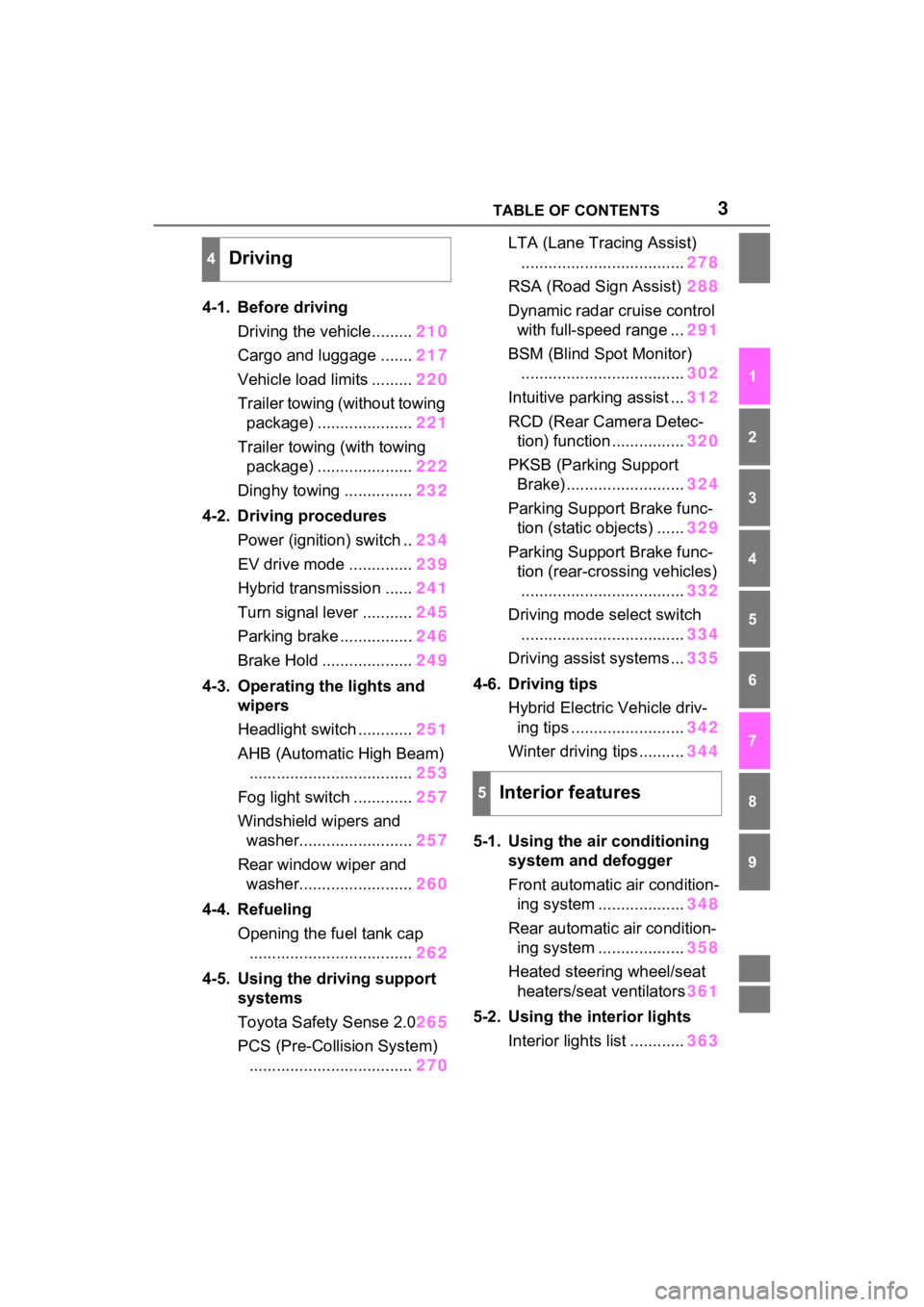
3TABLE OF CONTENTS
1
2
3
4
5
6
7
8
9
4-1. Before drivingDriving the vehicle......... 210
Cargo and luggage ....... 217
Vehicle load limits ......... 220
Trailer towing (without towing package) ..................... 221
Trailer towing (with towing package) ..................... 222
Dinghy towing ............... 232
4-2. Driving procedures Power (ignition) switch .. 234
EV drive mode .............. 239
Hybrid transmission ...... 241
Turn signal lever ........... 245
Parking brake ................ 246
Brake Hold .................... 249
4-3. Operating the lights and wipers
Headlight switch ............ 251
AHB (Automatic High Beam) .................................... 253
Fog light switch ............. 257
Windshield wipers and washer......................... 257
Rear window wiper and washer......................... 260
4-4. Refueling Opening the fuel tank cap.................................... 262
4-5. Using the driving support
systems
Toyota Safety Sense 2.0 265
PCS (Pre-Collision System) .................................... 270LTA (Lane Tracing Assist)
.................................... 278
RSA (Road Sign Assist) 288
Dynamic radar cruise control with full-speed range ... 291
BSM (Blind Spot Monitor) .................................... 302
Intuitive parking assist ... 312
RCD (Rear Camera Detec- tion) function ................ 320
PKSB (Parking Support Brake) .......................... 324
Parking Support Brake func- tion (static objects) ...... 329
Parking Support Brake func- tion (rear-crossing vehicles).................................... 332
Driving mode s elect switch
.................................... 334
Driving assist systems ... 335
4-6. Driving tips Hybrid Electric Vehicle driv-ing tips ......................... 342
Winter driving tips .......... 344
5-1. Using the ai r conditioning
system and defogger
Front automatic air condition- ing system ................... 348
Re ar automatic air condition-
i n
g system ................... 358
Heated steering wheel/seat heaters/seat ventilators 361
5-2. Using the interior lights Interior lights list ............ 363
4Driving
5Interior features
Page 4 of 602
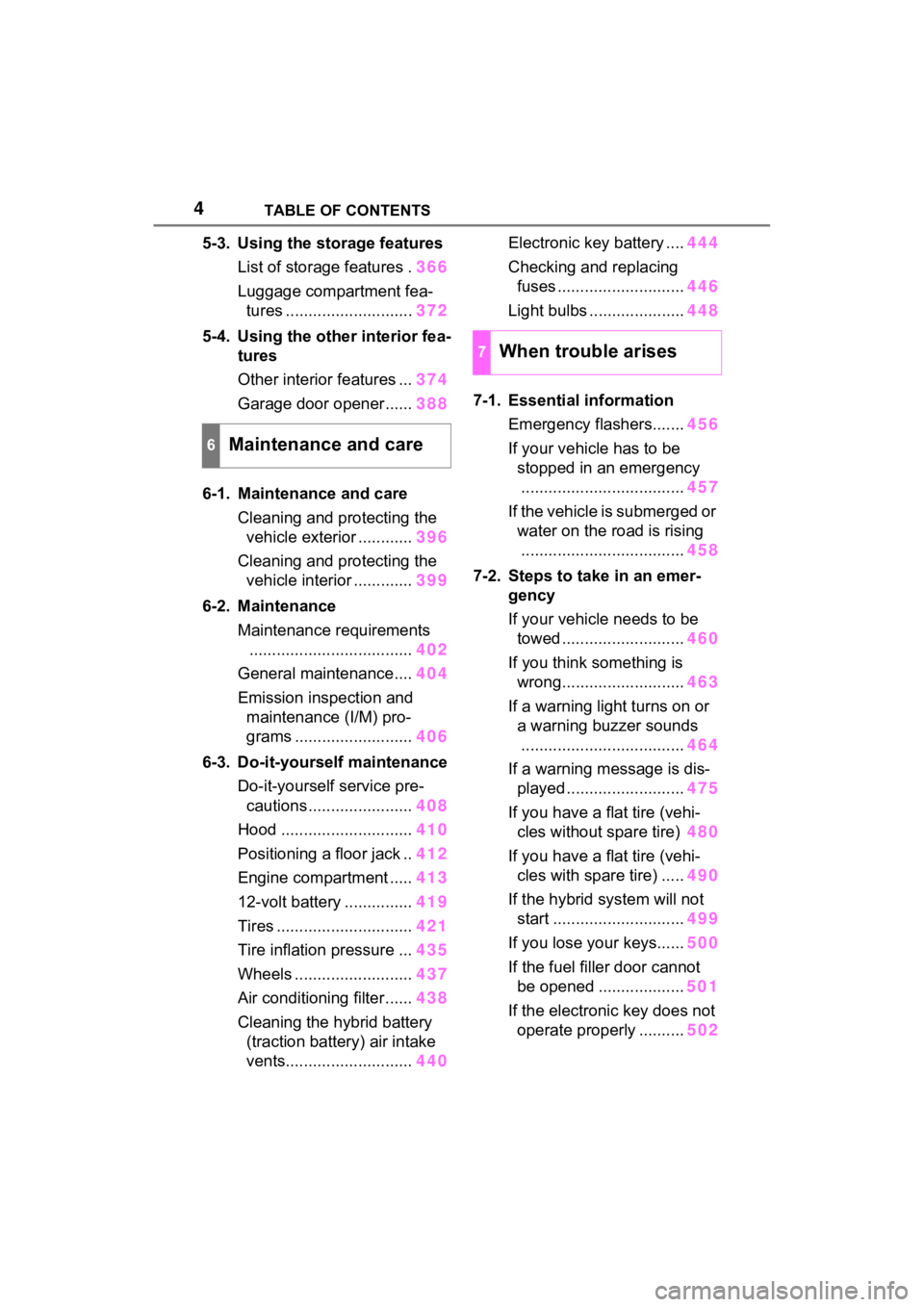
4TABLE OF CONTENTS
5-3. Using the storage featuresList of storage features . 366
Luggage compartment fea- tures ............................ 372
5-4. Using the other interior fea- tures
Other interior features ... 374
Garage door opener...... 388
6-1. Maintenance and care Cleaning and protecting the vehicle exterior ............ 396
Cleaning and protecting the vehicle interior ............. 399
6-2. Maintenance Maintenance requirements.................................... 402
General maintenance.... 404
Emission inspection and maintenance (I/M) pro-
grams .......................... 406
6-3. Do-it-yourself maintenance Do-it-yourself service pre-cautions ....................... 408
Hood ............................. 410
Positioning a floor jack .. 412
Engine compartment ..... 413
12-volt battery ............... 419
Tires .............................. 421
Tire inflation pressure ... 435
Wheels ......... .................437
Air conditioning filter ...... 438
Cleaning the hybrid battery (traction battery) air intake
vents............................ 440Electronic key battery ....
444
Checking and replacing fuses ............................ 446
Light bulbs ..................... 448
7-1. Essential information Emergency flashers....... 456
If your vehicle has to be stopped in an emergency.................................... 457
If the vehicle is submerged or water on the road is rising.................................... 458
7-2. Steps to take in an emer- gency
If your vehicle needs to be towed ........................... 460
If you think something is wrong........................... 463
If a warning light turns on or a warning buzzer sounds
.................................... 464
If a warning message is dis- played .......................... 475
If you have a flat tire (vehi- cles without spare tire)480
If you have a flat tire (vehi- cles with spare tire) ..... 490
If the hybrid system will not start ............................. 499
If you lose your keys...... 500
If the fuel fille r door cannot
be opened ................... 50
1
I f th
e electronic key does not
operate properly .......... 502
6Maintenance and care
7When trouble arises
Page 21 of 602
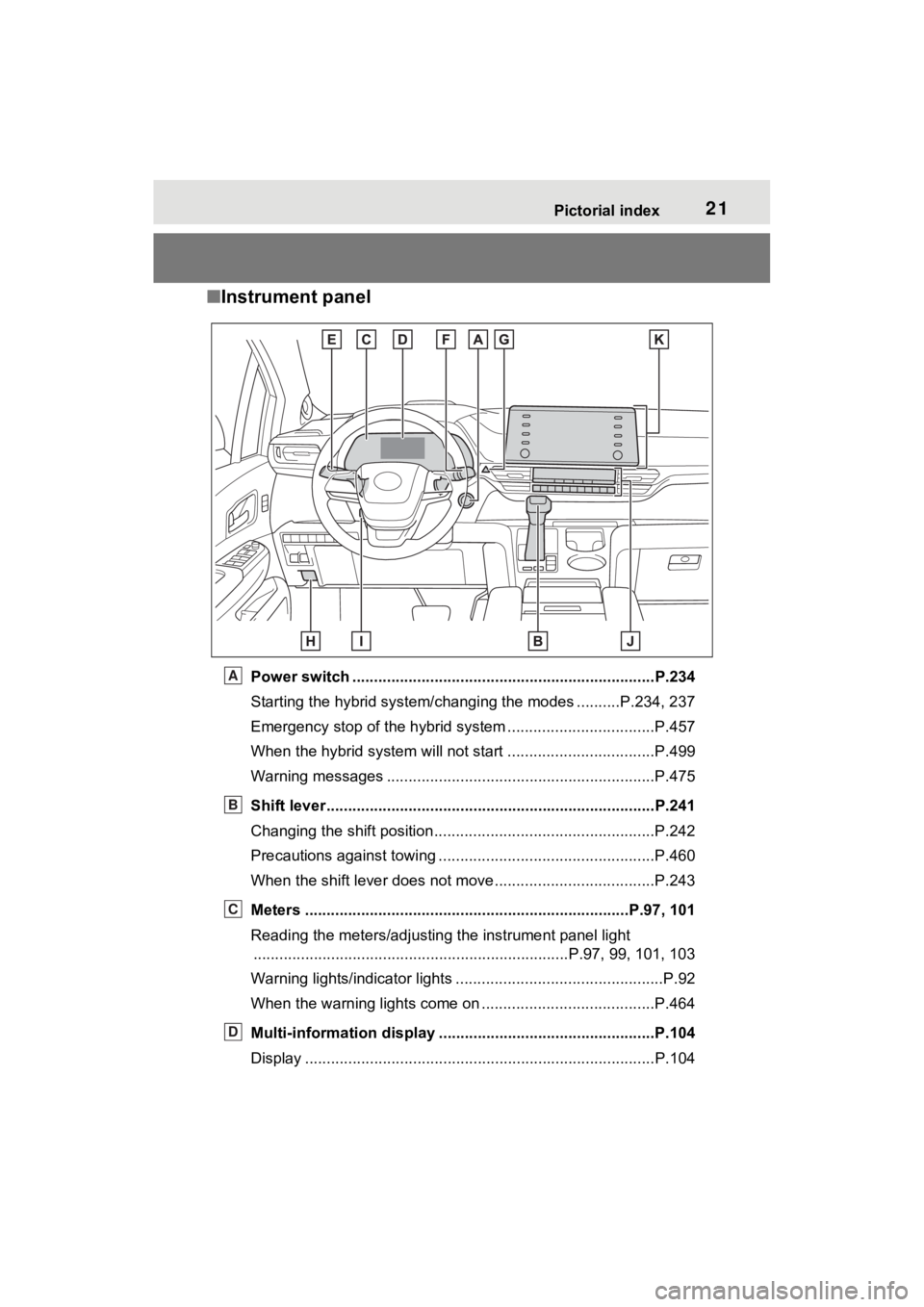
21Pictorial index
■Instrument panel
Power switch ................................................... ...................P.234
Starting the hybrid system/chan ging the modes ..........P.234, 237
Emergency stop of the hybrid system ............................ ......P.457
When the hybrid system will not start .......................... ........P.499
Warning messages ..............................................................P.475
Shift lever.................................................... ........................P.241
Changing the shift position.................................... ...............P.242
Precautions against towing ..................................................P.460
When the shift lever does not move............................. ........P.243
Meters ......................................................... ..................P.97, 101
Reading the meters/adjusting the instrument panel light ............................................................... ..........P.97, 99, 101, 103
Warning lights/indicator lights ................................ ................P.92
When the warning lights come on ................................ ........P.464
Multi-information display . .................................................P.104
Display .................................................................................P.104A
B
C
D
Page 38 of 602
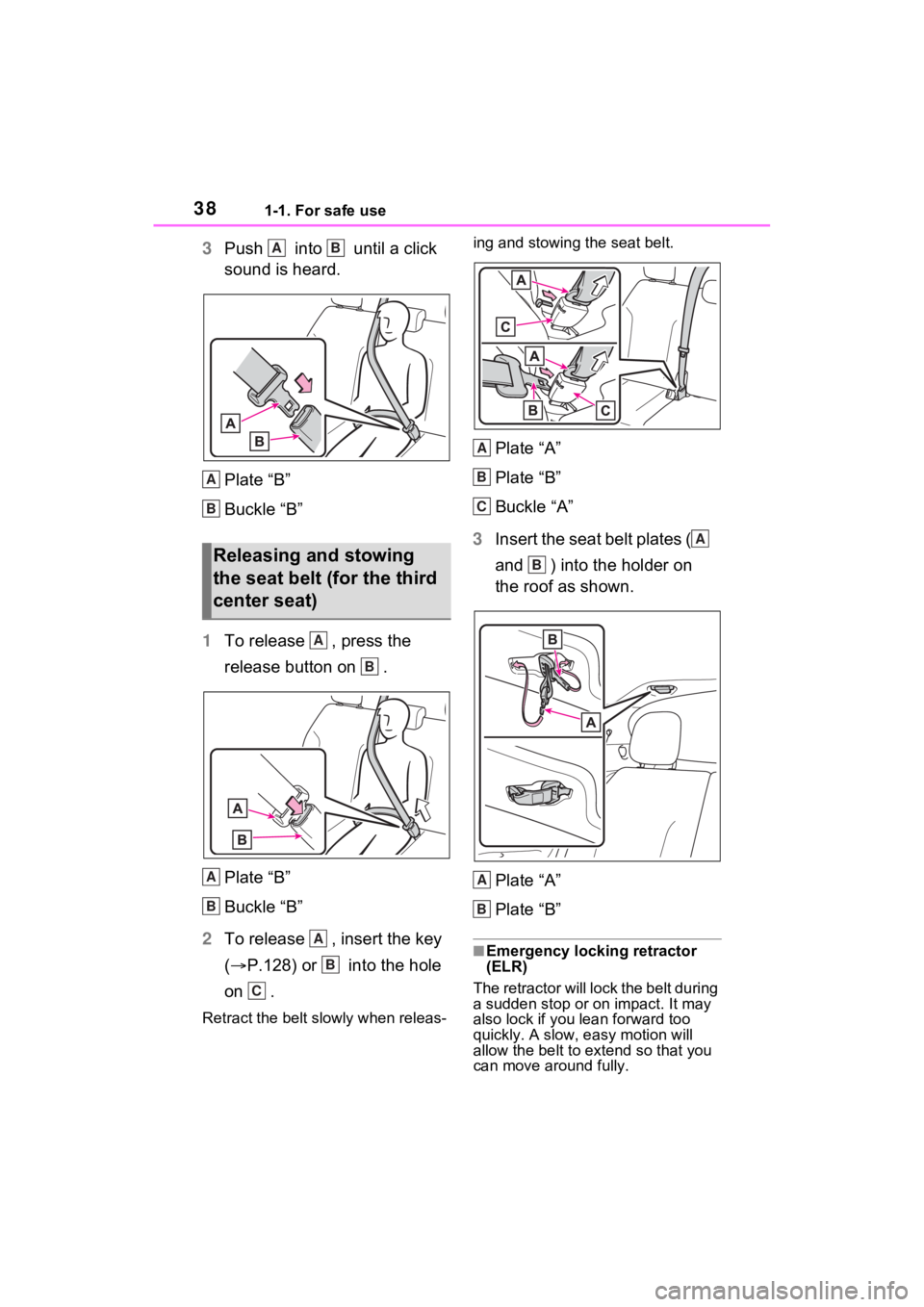
381-1. For safe use
3Push into until a click
sound is heard.
Plate “B”
Buckle “B”
1 To release , press the
release button on .
Plate “B”
Buckle “B”
2 To release , insert the key
( P.128) or into the hole
on .
Retract the belt slowly when releas- ing and stowing the seat belt.
Plate “A”
Plate “B”
Buckle “A”
3 Insert the seat belt plates (
and ) into the holder on
the roof as shown.
Plate “A”
Plate “B”
■Emergency locking retractor
(ELR)
The retractor will lock the belt during
a sudden stop or on impact. It may
also lock if you lean forward too
quickly. A slow, easy motion will
allow the belt to extend so that you
can move around fully.
Releasing and stowing
the seat belt (for the third
center seat)
AB
A
B
A
B
A
B
A
B
C
A
B
C
A
B
A
B
Page 47 of 602
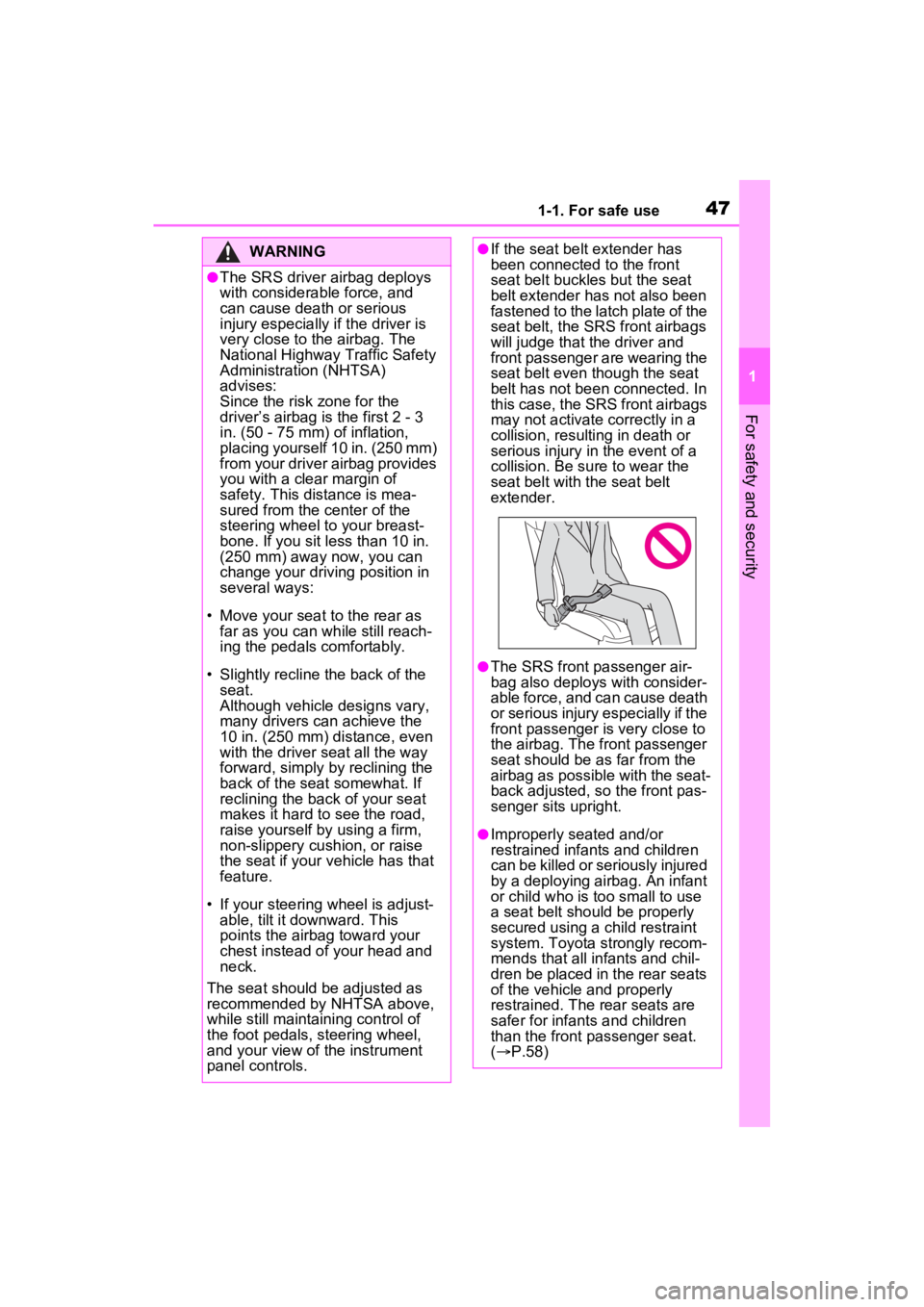
471-1. For safe use
1
For safety and security
WARNING
●The SRS driver airbag deploys
with considerable force, and
can cause death or serious
injury especially i f the driver is
very close to the airbag. The
National Highway Traffic Safety
Administration (NHTSA)
advises:
Since the risk zone for the
driver’s airbag is the first 2 - 3
in. (50 - 75 mm) of inflation,
placing yourself 10 in. (250 mm)
from your driver airbag provides
you with a clear margin of
safety. This distance is mea-
sured from the center of the
steering wheel to your breast-
bone. If you sit less than 10 in.
(250 mm) away now, you can
change your driving position in
several ways:
• Move your seat to the rear as far as you can while still reach-
ing the pedals comfortably.
• Slightly recline the back of the seat.
Although vehicle designs vary,
many drivers can achieve the
10 in. (250 mm) distance, even
with the driver seat all the way
forward, simply by reclining the
back of the seat somewhat. If
reclining the back of your seat
makes it hard to see the road,
raise yourself by using a firm,
non-slippery cushion, or raise
the seat if your vehicle has that
feature.
• If your steering wheel is adjust- able, tilt it downward. This
points the airbag toward your
chest instead of your head and
neck.
The seat should be adjusted as
recommended by NHTSA above,
while still maintaining control of
the foot pedals, steering wheel,
and your view of the instrument
panel controls.
●If the seat belt extender has
been connected to the front
seat belt buckles but the seat
belt extender has not also been
fastened to the latch plate of the
seat belt, the SRS front airbags
will judge that the driver and
front passenger are wearing the
seat belt even though the seat
belt has not been connected. In
this case, the SRS front airbags
may not activate correctly in a
collision, resulting in death or
serious injury in the event of a
collision. Be su re to wear the
seat belt with the seat belt
extender.
●The SRS front passenger air-
bag also deploys with consider-
able force, and can cause death
or serious injury especially if the
front passenger is very close to
the airbag. The front passenger
seat should be as far from the
airbag as possible with the seat-
back adjusted, so the front pas-
senger sits upright.
●Improperly seated and/or
restrained infants and children
can be killed or seriously injured
by a deploying airbag. An infant
or child who is too small to use
a seat belt should be properly
secured using a child restraint
system. Toyota strongly recom-
mends that all infants and chil-
dren be placed in the rear seats
of the vehicle and properly
restrained. The rear seats are
safer for infants and children
than the front passenger seat.
( P.58)
Page 48 of 602
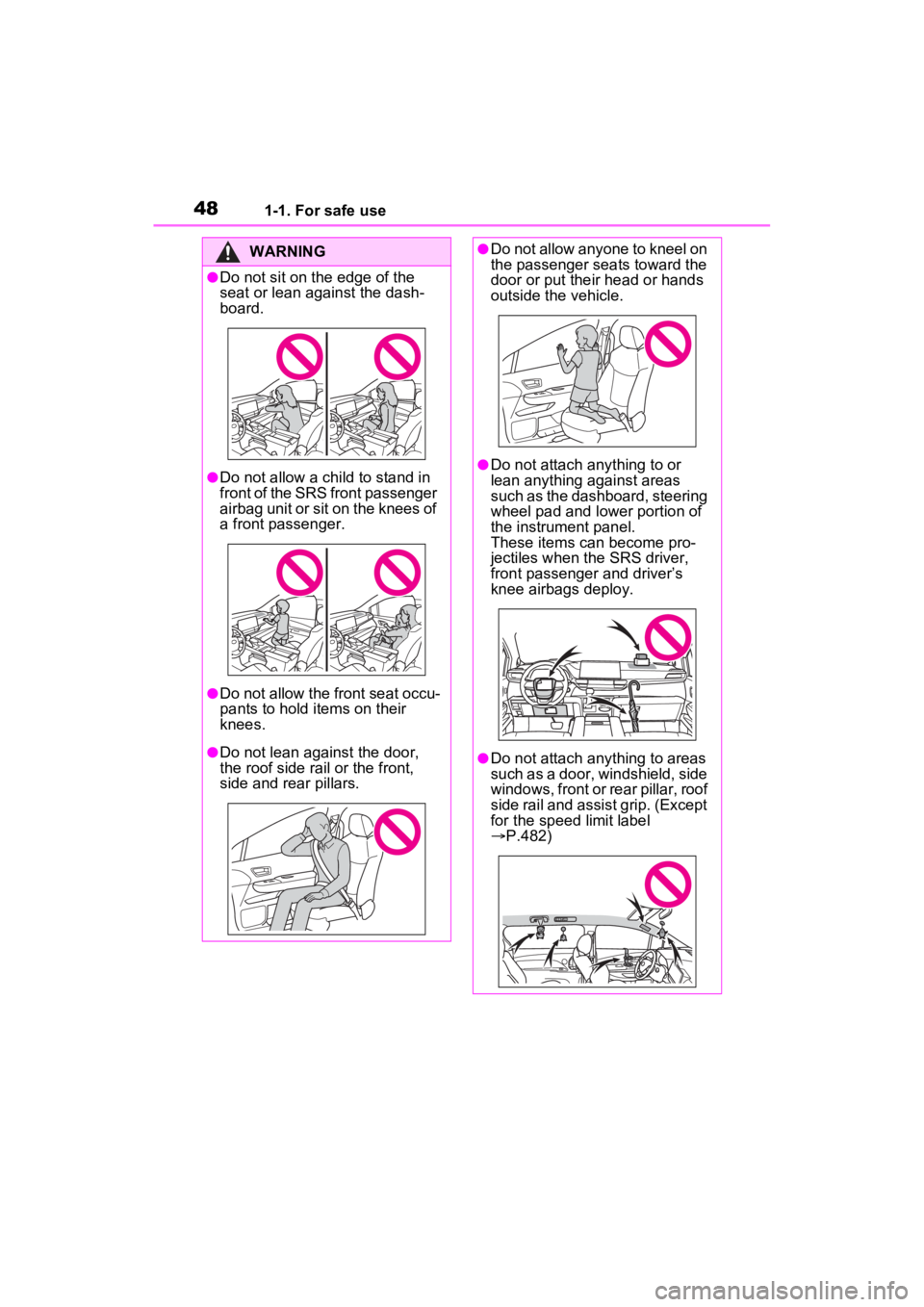
481-1. For safe use
WARNING
●Do not sit on the edge of the
seat or lean against the dash-
board.
●Do not allow a child to stand in
front of the SRS front passenger
airbag unit or sit on the knees of
a front passenger.
●Do not allow the front seat occu-
pants to hold items on their
knees.
●Do not lean against the door,
the roof side rail or the front,
side and rear pillars.
●Do not allow anyone to kneel on
the passenger seats toward the
door or put their head or hands
outside the vehicle.
●Do not attach anything to or
lean anything against areas
such as the dashboard, steering
wheel pad and lower portion of
the instrument panel.
These items can become pro-
jectiles when the SRS driver,
front passenger and driver’s
knee airbags deploy.
●Do not attach anything to areas
such as a door, windshield, side
windows, front or rear pillar, roof
side rail and assist grip. (Except
for the speed limit label
P.482)
Page 67 of 602
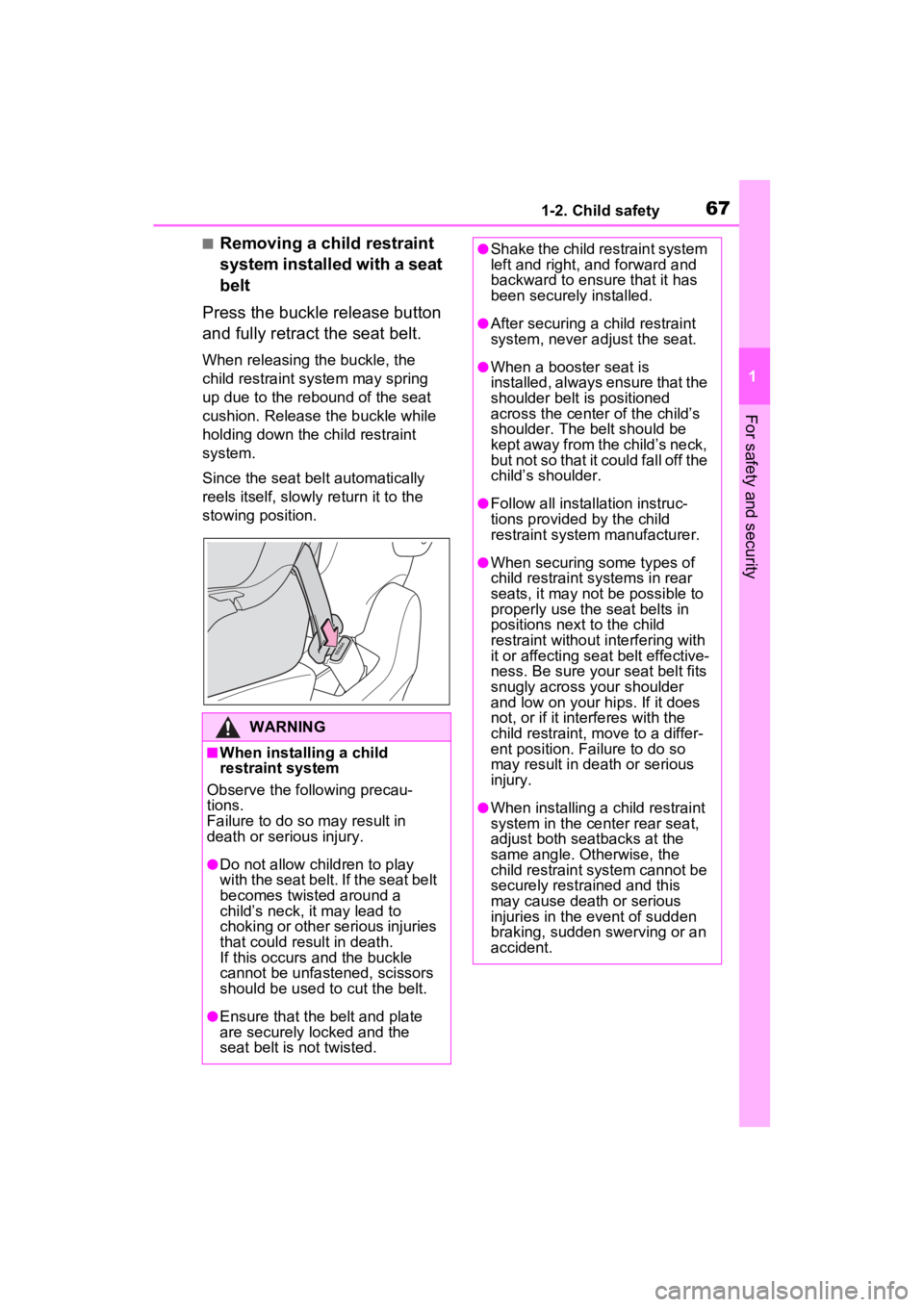
671-2. Child safety
1
For safety and security
■Removing a child restraint
system installed with a seat
belt
Press the buckle release button
and fully retract the seat belt.
When releasing the buckle, the
child restraint system may spring
up due to the rebound of the seat
cushion. Release the buckle while
holding down the child restraint
system.
Since the seat belt automatically
reels itself, slowly return it to the
stowing position.
WARNING
■When installing a child
restraint system
Observe the following precau-
tions.
Failure to do so m ay result in
death or serious injury.
●Do not allow children to play
with the seat belt. If the seat belt
becomes twisted around a
child’s neck, it may lead to
choking or other serious injuries
that could result in death.
If this occurs and the buckle
cannot be unfastened, scissors
should be used to cut the belt.
●Ensure that the belt and plate
are securely locked and the
seat belt is not twisted.
●Shake the child restraint system
left and right, and forward and
backward to ensure that it has
been securely installed.
●After securing a child restraint
system, never adjust the seat.
●When a booster seat is
installed, always ensure that the
shoulder belt is positioned
across the center of the child’s
shoulder. The belt should be
kept away from the child’s neck,
but not so that it could fall off the
child’s shoulder.
●Follow all installation instruc-
tions provided by the child
restraint system manufacturer.
●When securing some types of
child restraint systems in rear
seats, it may not be possible to
properly use the seat belts in
positions next to the child
restraint without interfering with
it or affecting s eat belt effective-
ness. Be sure your seat belt fits
snugly across your shoulder
and low on your hips. If it does
not, or if it interferes with the
child restraint, move to a differ-
ent position. Fa ilure to do so
may result in death or serious
injury.
●When installing a child restraint
system in the ce nter rear seat,
adjust both seatbacks at the
same angle. Otherwise, the
child restraint system cannot be
securely restrained and this
may cause death or serious
injuries in the event of sudden
braking, sudden swerving or an
accident.
Page 78 of 602

781-3. Emergency assistance
■Enhanced Roadside Assis-
tance
Enhanced Roadside Assistance
adds GPS data to the already
included warranty-based Toyota
roadside service.
Subscribers can press the
“SOS” button to reach a Safety
Connect response-center agent,
who can help with a wide range
of needs, such as: towing, flat
tire, fuel delivery, etc. For a
description of the Enhanced
Roadside Assistance services
and their limitations, please see
the Safety Connect Terms and
Conditions, which are available
at Toyota.com in the United
States, Toyotapr.com in Puerto
Rico and Toyota.ca in Canada.
Important! Read this informa-
tion before using Safety Con-
nect.
■Exposure to radio fre-
quency signals
The Safety Connect system
installed in your vehicle is a low-
power radio transmitter and
receiver. It receives and also
sends out radio frequency (RF)
signals.
In August 1996, the Federal
Communications Commission
(FCC) adopted RF exposure
guidelines with safety levels for mobile wireless phones. Those
guidelines are consistent with
the safety standards previously
set by the following U.S. and
international standards bodies.
ANSI (American National
Standards Institute) C95.1
[1992]
NCRP (National Council on
Radiation Protection and
Measurement) Report 86
[1986]
ICNIRP (International Com-
mission on Non-Ionizing Radi-
ation Protection) [1996]
Those standards were based on
comprehensive and periodic
evaluations of the relevant sci-
entific literature. Over 120 scien-
tists, engineers, and physicians
from universities, and govern-
ment health agencies and
industries reviewed the avail-
able body of research to
develop the ANSI Standard
(C95.1).
The design of Safety Connect
complies with the FCC guide-
lines in addition to those stan-
dards.
Safety information for
Safety Connect
Page 85 of 602
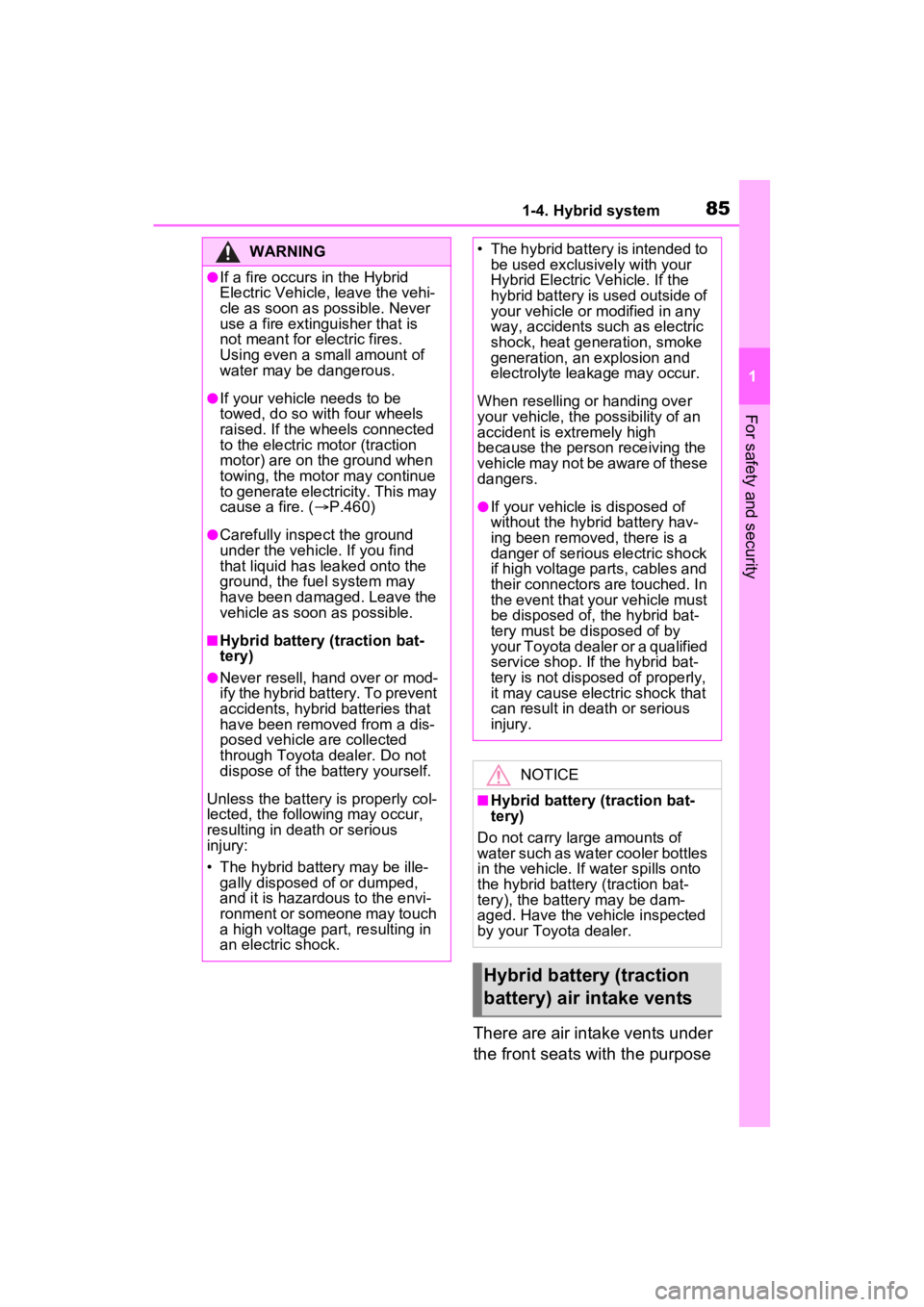
851-4. Hybrid system
1
For safety and security
There are air intake vents under
the front seats with the purpose
WARNING
●If a fire occurs in the Hybrid
Electric Vehicle, leave the vehi-
cle as soon as possible. Never
use a fire extinguisher that is
not meant for electric fires.
Using even a small amount of
water may be dangerous.
●If your vehicle needs to be
towed, do so with four wheels
raised. If the wheels connected
to the electric motor (traction
motor) are on the ground when
towing, the motor may continue
to generate electricity. This may
cause a fire. (P.460)
●Carefully inspect the ground
under the vehicle. If you find
that liquid has leaked onto the
ground, the fuel system may
have been damaged. Leave the
vehicle as soon as possible.
■Hybrid battery (traction bat-
tery)
●Never resell, hand over or mod-
ify the hybrid battery. To prevent
accidents, hybrid batteries that
have been removed from a dis-
posed vehicle are collected
through Toyota dealer. Do not
dispose of the battery yourself.
Unless the battery is properly col-
lected, the follo wing may occur,
resulting in dea th or serious
injury:
• The hybrid battery may be ille- gally disposed of or dumped,
and it is hazardous to the envi-
ronment or someone may touch
a high voltage part, resulting in
an electric shock.
• The hybrid battery is intended to be used exclusively with your
Hybrid Electric Vehicle. If the
hybrid battery is used outside of
your vehicle or modified in any
way, accidents such as electric
shock, heat generation, smoke
generation, an explosion and
electrolyte leakage may occur.
When reselling or handing over
your vehicle, the possibility of an
accident is extremely high
because the person receiving the
vehicle may not be aware of these
dangers.
●If your vehicle is disposed of
without the hybrid battery hav-
ing been removed, there is a
danger of serious electric shock
if high voltage parts, cables and
their connectors are touched. In
the event that your vehicle must
be disposed of, the hybrid bat-
tery must be disposed of by
your Toyota dealer or a qualified
service shop. If the hybrid bat-
tery is not disposed of properly,
it may cause electric shock that
can result in dea th or serious
injury.
NOTICE
■Hybrid battery (traction bat-
tery)
Do not carry large amounts of
water such as water cooler bottles
in the vehicle. If water spills onto
the hybrid battery (traction bat-
tery), the battery may be dam-
aged. Have the vehicle inspected
by your Toyota dealer.
Hybrid battery (traction
battery) air intake vents
Page 146 of 602

1443-2. Opening, closing and locking the doors
■If the power sliding door is
inoperative
When the power sliding door
detects an abnormality and stops
opening and can no t be completely
closed manually, turn the inside lock
button to “LOCK” position to cancel
the function and close the door
manually. After th at, have the vehi-
cle inspected and repaired by your
Toyota dealer.
■Kick sensor operating condi-
tions (vehicles with Hands Free
Power Sliding Doors)
The Hands Free Power Sliding Door
will open/close automatically when
the following cond itions are met:
●The kick sensor operation is
enabled ( P.112)
●The front door (t he same side of
the sliding door you open) is
closed.
●The electronic key is within the
operational range. ( P.165)
●A foot is put under the portion with
a label on the rocker moulding
and moved away from the rocker
moulding.
The power sliding door may also
be operated by putting a hand, an
elbow, a knee, etc. under the por-
tion with a label on the rocker
moulding and moving it away from
the rocker moulding. Make sure to
put it close enough to the center
part of the rocker moulding.
■Situations in which the Hands
Free Power Sliding Door may
not operate properly (vehicles
with Hands Free Power Sliding
Doors)
In the following situations, the
Hands Free Power Sliding Door
may not operate properly:
●When a foot remains under the
rocker moulding
●If the rocker moulding is strongly
hit with a foot or is touched for a
while If the rocker moulding has been
touched for a while, wait for a short
time before attempting to operate
the Hands Free Power Sliding Door
again.
●When operated while a person is
too close to the rocker moulding
●When an external radio wave
source interferes with the commu-
nication between the electronic
key and the vehicle (
P.166)
●When the vehicle is parked near
an electrical noise source which
affects the sensitivity of the Hands
Free Power Sliding Door, such as
a pay parking spot, gas station,
electrically heated road, or fluo-
rescent light
●When the vehicle is near a TV
tower, electric po wer plant, radio
station, large display, airport or
other facility that generates strong
radio waves or electrical noise
●When a large amount of water is
applied to the r ocker moulding,
such as when the v ehicle is being
washed or in heavy rain
●When mud, snow, ice, etc. is
attached to the rocker moulding
●When the vehicle has been
parked for a while near objects
that may move and contact the
rocker moulding, such as plants
●When an accessory i s installed to
the rocker moulding
If an accessory has been installed,
turn the Hands Fre e Power Sliding
Door (kick sensor) operation setting
off.
■Preventing unintentional opera-
tion of the Hands Free Power
Sliding Door (vehicles with
Hands Free Power Sliding
Doors)
When an electronic key is in the
operation range, the Hands Free
Power Sliding Do or may operate
unintentionally, so be careful in the